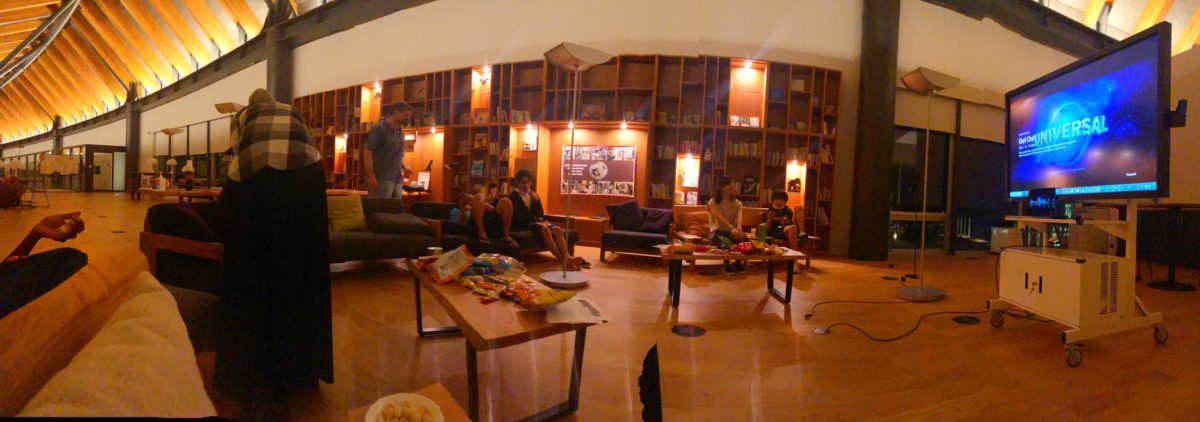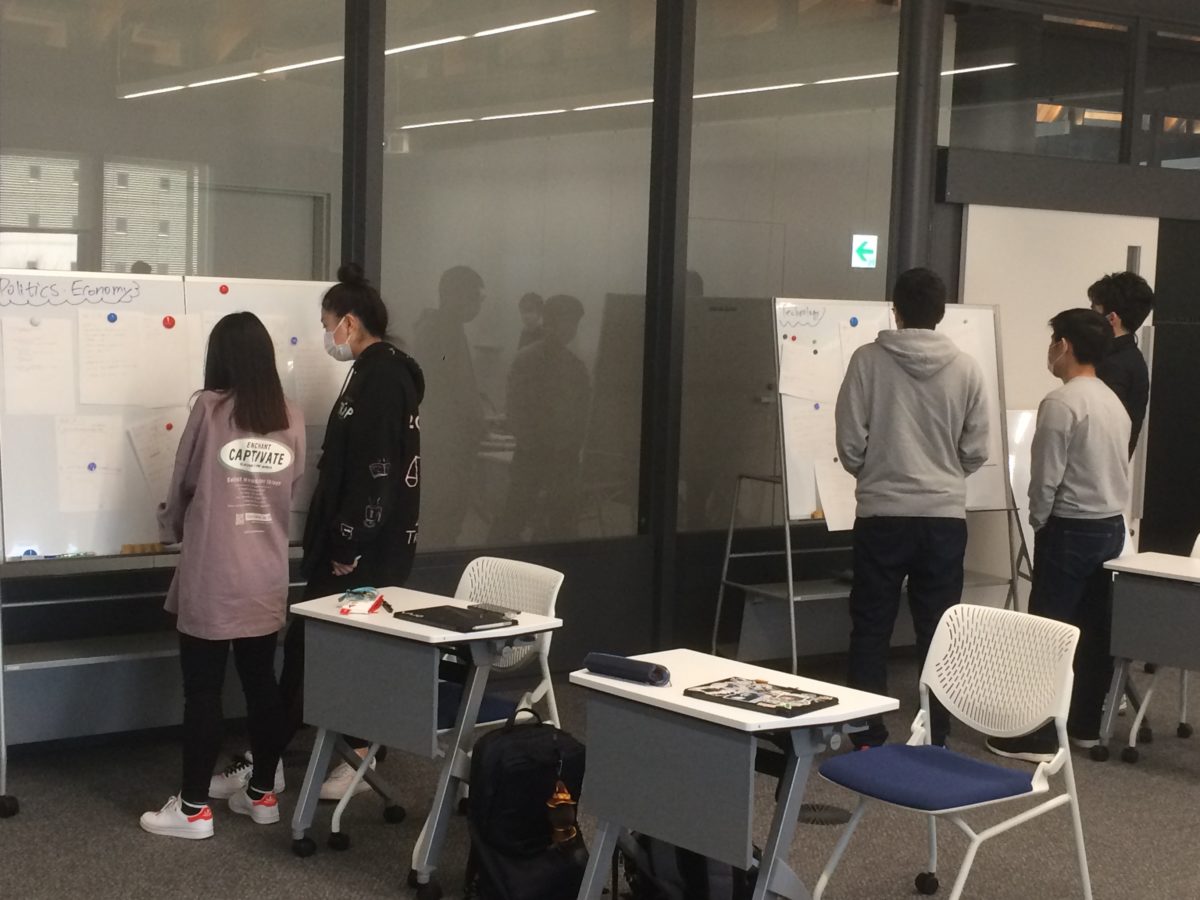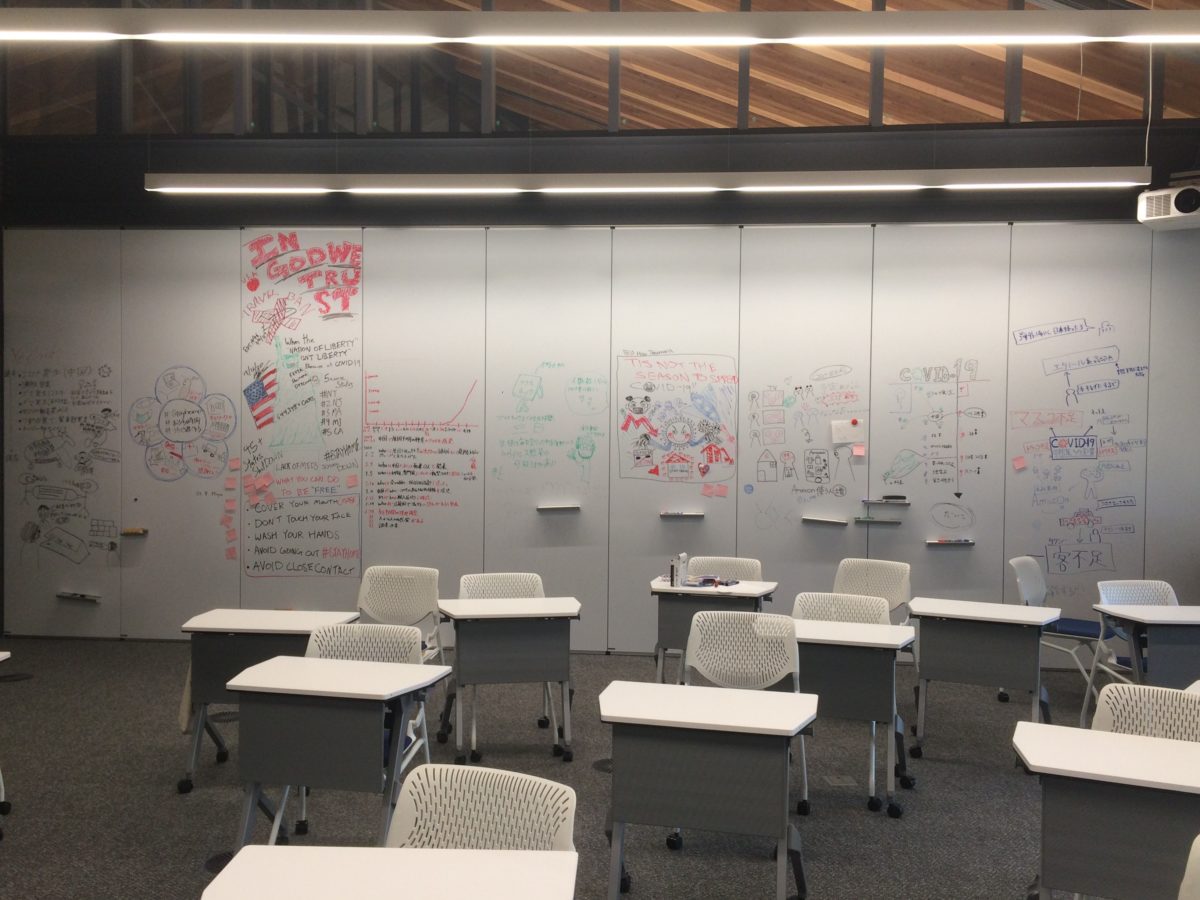 At ICT, we apply active learning methods in our classes. Most of the time, people think that active learning takes place only when students are involved in group activities or discussions. However, active learning is a lot wider term that takes place when students are more engaged, involved in the learning process where they are responsible of developing skills and gaining knowledge. The role of educators in the active learning process is to create chances, facilitate the materials, and draw students’ interest into new topics.
At ICT, we apply active learning methods in our classes. Most of the time, people think that active learning takes place only when students are involved in group activities or discussions. However, active learning is a lot wider term that takes place when students are more engaged, involved in the learning process where they are responsible of developing skills and gaining knowledge. The role of educators in the active learning process is to create chances, facilitate the materials, and draw students’ interest into new topics.
In Chemistry classes, students are involved in the learning process in all different ways. Besides, taking notes, performing experiments, and take part in the class or group discussions, students are required to create their own portfolios. In Chemistry Portfolios, students need to include all the possible learning evidences, and journal entries that show how they reflect on their own learning process and gained skills. As I watch my students’ portfolios and read their entries, I learn more about my students as individual learners and people. While reading how they think about what was interesting, challenging, or new, I discovered that our roles as educators is to show our students the doors and give them the keys. Students then decide which door to open and discover a whole new world. I enjoyed reading what my students wrote in their entries. I took S2 students’ permission to pick some examples to share with you, and here they are.
Taketora wrote, “First thing that I was interested in was that water in solid state is less dense than in liquid state. Actually, I knew that, but I didn’t know why. Water molecules are polar bonded. When they form ice, they are arranged in hexagonal shape because polar forces attract and also repel water molecules. I understand why ice floats on water.”
Daiko wrote, “While studying Chemistry IIA, I felt that an understanding of chemistry is essential to understanding nature!”
Shuntaro wrote, “Also, that plasma is the fourth state of matter is new knowledge for me. I did not know about plasma because I never saw it before and the textbook in secondary school that only told me about 3 states of matter.”
Luca wrote, “In terms of learning skills, I have developed skills of getting used to the online learning system using zoom.”
Koutaro wrote, “The most shocking experience in Chemistry IIA was learning that there aren’t only three states of matter, but that there is another, plasma. I heard about a plasma cutter, but I never researched how it works and what the plasma is. Conclusively, Chemistry IIA was an enjoyable and very interesting subject for me. I believe Chemistry IIB will be even more interesting.”
Anna wrote, “I was very interested in experiments. I learned it is important to continue to study and chip away at studying.”
Mao wrote, “Whilst studying Chemistry IIA I have developed many learning skills and study habits that have helped me not only in chemistry but all other subjects. Taking Chemistry IIA has made me see that a lot of what we learn in class has relevance to the real world and are not just concepts for school. It was also interesting to see some of the concepts and ideas I learned as a first-year student intertwining and relating to some of the topics I learn as a second year.”
Miyu wrote, “I will never forget about the topic of particles because it has a relationship with the sunset’s color. I am curious about the sunset’s colors. I'll research more about this relationship during my STEM project 2020. Overall, I did my best this semester. The class was interesting and I learned a lot of new things. I will try everything next semester.”
Yoshiki wrote, “I believe there are lots of skills I have learned during the first semester. One of it is to read the textbook before the chemistry class and take notes about important words. Overall, during this semester, I learned a lot of things about the use of science in daily life, chemical reactions, chemical names, the states of matter, and so on. All of these topics are important for our future and our life.”
Yuudai wrote, “Lastly, I will never forget the information about the states of matter because it might be used in the future to distinguish things.”
Nagwa Fekri Rashed

化学のポートフォリオ
国際高専の授業では、アクティブラーニングを実践しています。アクティブラーニングはグループ活動やディスカッションの時にしか使えないと思われがちですが、アクティブラーニングは学生が積極的に授業に参加していて、能動的に技能を高めたり、知識を獲得したりする時に使用できる、もっと広い意味を持つ表現です。アクティブラーニング時の教師の役割は学生に学ぶ環境を整え、教材を用意し、新しいトピックへ興味を向けさせることです。
化学の授業では、学生は様々な手段で学習しています。ノートを取る、実験を行う、グループディスカッションに参加する以外に、学生たちはポートフォリオを作ります。化学のポートフォリオでは、学生は可能な限り学習エヴィデンスを残して、学習や上達したスキルについて振り返るジャーナルの記入が求められます。学生のポートフォリオを読むことで、学習する姿勢や内面を知ることができます。どんな授業内容を面白い、難しい、新鮮と感じるかどうかを読むことで、教育者として学生に扉を示して鍵を渡す役割を再確認します。学生は好きな扉を選んでまったく新しい世界を発見するのです。ジャーナルを読むのは本当に楽しいです。2年生の許可を得ていくつか載せますので、ぜひ読んでみてください。
武虎『最初に興味が湧いたのは固体の水が液体より密度が大きいということです。そのことは知っていましたが、理由がわかりませんでした。水の分子はポーラー結合です。氷になる時、polar forceが水の分子を引き寄せると同時にはじくので六角形の配置になります。氷が水に浮かぶ理由がわかりました。』
大虎『化学IIAを勉強していると、化学を学ぶということは自然の本質を理解することにつながると感じました!』
俊太朗『プラズマが物質の4番目の状態であることを初めて知りました。これまではプラズマを見たことがなかったし、中学の教科書には物質の状態は3種類と載っていました。』
瑠華『学習スキルの上達という意味では、Zoomを使ったオンライン授業に慣れてきました。』
晃太朗『化学IIAで1番驚いたのは物質の状態が3つだけではなく、プラズマという状態があることです。プラズマカッターは知っていましたが、その仕組みやプラズマが何なのかを調べたことがありませんでした。結果的に、化学IIAは楽しく学習できる面白い科目でした。化学IIBはもっと面白いだろうと期待しています。』
杏奈『実験が面白かったです。コツコツ勉強することの大切さを学びました。』
真央『化学IIAのために勉強することで、ほかの科目にも役立つ学習スキルや習慣を身に着けることができました。化学IIAを通して、教室で学ぶ内容は学校に留まらず、その後の人生に役立つことが実感できました。また、1年目に習ったいくつかの内容が2年目の学習に絡んでくるところが面白かったです。』
美結『夕日の色に関係しているので、粒子の勉強は忘れません。夕日の色に興味があるので、今年のSTEMプロジェクトでもっと詳しく調査します。振り返ると、今学期は最善を尽くしたと思います。授業は面白かったし、新しいことをたくさん学べました。来年もすべてのことに挑戦します。』
義基『前学期は色んな学習スキルを身に着けることができました。ひとつは化学の授業の前に教科書を読んで重要な単語をメモすることです。今学期は化学反応、化学薬品、分子の状態など、日常生活に役立つ化学をたくさん学びました。今後の人生に重要な内容だと思います。
祐大『最後に、分子の状態について学んだ内容は将来役立つと思うので忘れません。』
ナグワ・ラシィド
 The English Language and Culture Club held their first event on July 29th. To celebrate finishing the first semester and their final exams hosted a movie night with snacks. This was the culmination of a four-week process, where the students did the following tasks
The English Language and Culture Club held their first event on July 29th. To celebrate finishing the first semester and their final exams hosted a movie night with snacks. This was the culmination of a four-week process, where the students did the following tasks
- Selected the movie they wanted to watch
- Made announcements about the movie in homeroom
- Questioned their classmates about the snacks they wanted
- Designed, made, customized and posted movie posters to promote movie night
- Made a flyer with information about the four main characters and the actors playing them
Finally, on the 29th, at 7:00, Mao, Shii, Afaf and Shiori gathered in the Learning Commons to set out the snacks and set up the movie. About 10 1st and 2nd year students joined them to celebrate the end of the semester and exams, eat snacks and watch the movie, Get Out. Get Out is a 2017 horror movie that was chosen by many organizations and publications as one of the ten best films of the year, nominated for four Academy Awards and won the Academy Award for Best Original Screenplay.
Ian Stevenson
 ランゲージ&カルチャークラブが今年度初となるイベントを7月29日に開催しました。前学期の期末試験終了を祝して開催されたムービーナイト(スナック菓子あり)です。準備としてメンバーは4週かけて以下のことをしました。
ランゲージ&カルチャークラブが今年度初となるイベントを7月29日に開催しました。前学期の期末試験終了を祝して開催されたムービーナイト(スナック菓子あり)です。準備としてメンバーは4週かけて以下のことをしました。
- 観たい映画の選出
- ホームルームで映画の告知
- クラスメイトから食べたいスナック菓子のアンケート調査
- 上映する映画のポスターのデザイン、制作、飾りつけ
- 主要登場人物4人の情報を載せたチラシの制作
最後に、29日の朝7時に、真央さん、史依さん、アファフさん、詩織さんがラーニングコモンズに集まってお菓子と映画のセッティングをしました。1,2年生合わせて約10名が集まって学期と試験の終わりを祝って映画「ゲット・アウト」とお菓子を堪能しました。「ゲット・アウト」は2017年のホラー映画で、多方面からその年のベスト映画トップ10に選ばれており、4つのアカデミー賞にノミネートされ、脚本賞を受賞しています。
イアン・スティーブンソン
 Hello everyone! It has been a while since my last entry. Suffice it to say that many things have happened since then. Our campus has had to make some adjustments to adapt to the reality of the COVID-19 pandemic. At the beginning of the school year in April, we were teaching normal face-to-face classes, but as the state of the pandemic worsened, we had no choice but to change to an online format. This was a big change for teachers and students and it required efforts on both sides. Thankfully, because our campus is quite isolated in the mountains, it was possible to come back to face-to-face classes after a few weeks. There were/are still countermeasures put in place to minimize the risk of infection like wearing a mask at all times and the possibility to work from home when there are no classes for example.
Hello everyone! It has been a while since my last entry. Suffice it to say that many things have happened since then. Our campus has had to make some adjustments to adapt to the reality of the COVID-19 pandemic. At the beginning of the school year in April, we were teaching normal face-to-face classes, but as the state of the pandemic worsened, we had no choice but to change to an online format. This was a big change for teachers and students and it required efforts on both sides. Thankfully, because our campus is quite isolated in the mountains, it was possible to come back to face-to-face classes after a few weeks. There were/are still countermeasures put in place to minimize the risk of infection like wearing a mask at all times and the possibility to work from home when there are no classes for example.
I teach biology class, so during the first class of the school year in April, I found it important to do a presentation and share information about the virus to the students. I presented the characteristics of the virus, the state of the pandemic up to that point and why it was/is important to follow the sanitary measures put in place by the different authorities. Students seemed interested and curious and I think it helped them somewhat grasp the gravity of the situation.
Japan has been doing better than many other countries in the world during this pandemic. Let’s hope this continues to be the case and that we will be spared a second wave. I am convinced that the situation will get better as long as people continue to follow the sanitary measures and don’t let their guard down.
Jason
皆さん、お久しぶりです!前回の投稿から世界の状況が大きく変わってしまいました。新型コロナウィルスのパンデミックに対処するため、白山麓キャンパスにおいても様々な処置がなされています。新学期が始まった4月は通常の対面授業をしていたのですが、感染が広がるにつれオンラインでの遠隔授業に移行せざるを得ませんでした。この変化は先生にとっても学生にとっても大きな負担となりました。しかし、白山麓キャンパスが山の中に孤立しているおかげで数週間後には元の対面授業に戻ることができました。現在もマスク着用を常時義務付けるなど、感染のリスクを軽減する処置が引き続き行われており、授業がない日は在宅勤務ができるようになっています。
私は生物の授業を教えていますので、4月の第1回目の授業で新型コロナウィルスに関する講義を行って、学生たちに正しい知識を持ってもらうことが重要だと考えました。ウィルスの性質、現在のパンデミックに繋がる世界の動き、そして行政が求めている消毒などの対策の重要性について話しました。学生たちは関心があった様子で、事の重大さが伝わったような気がします。
世界的に見ると、日本は被害を抑えているほうだと思います。これがこのまま続き、第2波を避けられることを祈っています。全員が油断せず衛生管理を継続すれば、状況は良くなると信じています。
ジェイソン
2年生の授業であるエンジニアリングデザインは、地域の生活文化を体験したうえで、エンジニアとしての創造的解決を目指すプロジェクト型の授業です。プロジェクト実施前には、事象をいろんな角度から観察し、構造を視覚化するトレーニングをします。視覚化による現状把握は、グループごとの意思の疎通を図り、情報共有のもと活動を活性化させる効果があります。このビジュアルシンキングによるトレーニングを学生は、遠隔授業にも関わらず能動的に取り組んでくれました。今回のコロナウイルスの発生のタイミングは、学生の持つ、エンジニア魂に火をつけたのかもしれません。6月中旬には、クラスの様子を感じる事が困難な遠隔授業という状況から、通常授業へ戻り、いよいよ地域交流による体験活動が始まりました。学生のそばで対応できることは教員にとっては嬉しいことです。
さて、白山麓地域の方々と関わりながら行われる授業はこれからが本番です。学生は教員と共に創造力を充分発揮し、ものづくりの楽しさを味わっていきます。遠隔授業で学んだビジュアルシンキングをもとに、今ある事象を我が身に置き換えて考え、適切な判断のできるエンジニアを育てていきたいものです。
ところで、今回のコロナウイルスにより、多くの場面で問題が起こりました。例えば、食品の割引券案から始まった日本の経済対策については、検討を重ね、2枚のマスクが忘れた頃に届きました。いったいどれだけの人が救われたのでしょうか。また、配布されたマスクにカビ付着や髪の毛の混入があった問題は、ものづくり姿勢の現れと言えるのではないでしょうか。この出来事は、グローバル化の弊害が垣間見えます。消費者は身を守るために製造場所や製造方法を把握しなくてはならず、食品や製品は安全かどうかを吟味して購入しなければならない時代となっています。今回の、不要不急の対策により社会生活の歯車は完全に機能を失うこととなりました。コロナウイルスにより潜伏していた、いろいろな問題は明らかにされはじめ、そこから生まれた国民の感情はどこにぶつけるべきでしょうか。
このような社会状況を自ら体験して改めて思うこと言えば、多角的に物事を考え適切な判断による創造的思考ができることの重要性です。学生は、一年間にわたるエンジニアリングデザインの授業を通じて、日本の伝統文化や様々な人の心に触れて行くこととなります。そこでは、深く物事を観察し多くの人の考え方を学ぶ事になります。これからの貴重でユニークな体験は、これからの時代にふさわしいエンジニアへと導くことでしょう。後の授業については他の先生方に紹介していただくことにしましょう。
小髙 有普
The second-year Engineering Design class is a project-based course in which students observe the culture of the local community and design a creative solution as an engineer. Before the projects start, we make sure to study the subject matter from multiple angles and train ourselves to visualize it as a whole. This visualization process is an efficient way to unify the group's understanding of the current situation. I am happy to report that students participated actively in this visual-thinking training, despite it being conducted online. Perhaps the COVID-19 situation has lit their heart fire as an engineer. Online classes make it difficult to get a general sense of the classroom atmosphere. In mid-June, we returned to the regular teaching style. I am glad that we are back to teaching the students face-to-face.
Finally, we can start collaborating with the local Hakusanroku community. Students and teachers will combine their creative minds to enjoy making things together. My goal is to create engineers that can put themselves in the shoes of a situation and make correct decisions accordingly, based on the visual-thinking training that we learned in the online portion of this year.
Now that I think of it, COVID-19 caused more problems. For example, Japan's measures to soften the blow to the economy started with discount tickets for groceries, and hesitantly added two masks, which arrived long after we forgot about them. I wonder how many people were saved by this? There was talk about some of the masks arriving with mold or hair attached to them. This could be a result of bad engineering and globalization. In our time, buyers must beware of where and how products are made, and whether food and other products are safe. The COVID-19 situation will put a halt to human lifestyle as we know it. The corona virus has exposed many problems hidden beneath the surface of our society. What should we, the Japanese population do about it?
The conclusion that I have arrived at after experiencing this state is the importance of the ability to view things from multiple angles to make the correct judgment and constructive thinking. ICT students will study traditional Japanese culture and the passion of people behind the scene in this year's Engineering Design class. They will learn how to deeply observe matters and the thoughts of many people. I believe this unique experience will lead them to become respectable engineers. I'll leave the introduction to the other classes up to my colleges.
Kodaka Arihiro
 Hi! This is Jonathan, the camera man. I would like to post a quick journal to show the first-year students' biology presentations. First-year students were divided into pairs or groups of three and given the assignment to research and given a presentation about anything biology related. Every year, this is one of the larger hurdles students have to overcome. Why? Because it's all in English! Most of this year's first-year students are Japanese who only started learning in English this April. Also, presentations are a big part of ICT's curriculum. If there is one thing you get used to, it's giving presentations. One student told me that, including this bio presentation, he had five presentations this week. I will post the videos below. Remember, these are presentations of students that many of, went to Japanese junior high schools six months ago. Enjoy.
Hi! This is Jonathan, the camera man. I would like to post a quick journal to show the first-year students' biology presentations. First-year students were divided into pairs or groups of three and given the assignment to research and given a presentation about anything biology related. Every year, this is one of the larger hurdles students have to overcome. Why? Because it's all in English! Most of this year's first-year students are Japanese who only started learning in English this April. Also, presentations are a big part of ICT's curriculum. If there is one thing you get used to, it's giving presentations. One student told me that, including this bio presentation, he had five presentations this week. I will post the videos below. Remember, these are presentations of students that many of, went to Japanese junior high schools six months ago. Enjoy.
こんにちは!ジョナサンです。先日行われた1年生の生物のプレゼンテーションをジャーナルに載せたいと思います。毎年、1年生の生物の授業では好きな生物関連のテーマを選んで、リサーチした内容を発表する課題が出されます。これは国際高専のひとつの登竜門となっています。なぜかって?英語で行われるからです!ほとんどの1年生は日本の中学校を卒業して、人生で初めて英語で教育を受けています。当然、英語でプレゼンテーションをするのも初めてです。さらに、国際高専ではプレゼンテーションが頻繁に登場します。この発表の前に学生のひとりが「今週プレゼンが5個もある!」と嘆いていました。嫌でもプレゼン能力も伸ばされるのです。動画を下に載せましたので、ぜひご覧ください。発表する多くの学生が半年前までは日本の中学校で勉強していたことを考えると、短時間で大きく成長したなって感じました。













